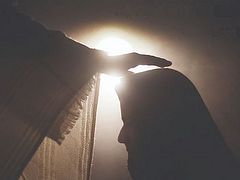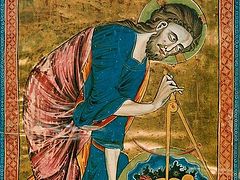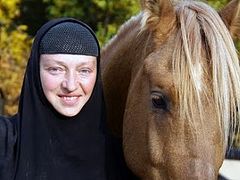 St. Gerasimus of the Jordan. By Oleg Shurkus / Shurkus.ru
St. Gerasimus of the Jordan. By Oleg Shurkus / Shurkus.ru
An acquaintance of mine, an elderly woman with a pure heart, decided to pray for her sick cat. But how was she supposed to do it? We pray for people this way: “Lord, have mercy on Thy servant so-and-so.” However, you can’t refer to a cat as a “servant of God.” In the end she said the following prayer: “Lord, have mercy on Thy cat, Vasily.”
And the pet recovered! Perhaps it is not a matter of the cat’s nine lives. Perhaps the Creator of the universe simply answered the prayer of the woman who had unconsciously obeyed the following commandment: Except ye be converted, and become as little children, ye shall not enter into the Kingdom of Heaven (Mt. 18:3). Indeed it is not a matter of the cat: it is a matter of that woman. Or the cat, too? What is the place of the animals in God’s universe? How are we supposed to perceive them? Are Christians expected to love and have pity on them? Can we pray for them, and, if so, how?
Let them have dominion…
In chapter 1 of Genesis we read about the creation of the universe:
And God said, Let the waters bring forth abundantly the moving creature that hath life, and fowl that may fly above the earth in the open firmament of heaven. And God created great whales, and every living creature that moveth, which the waters brought forth abundantly, after their kind, and every winged fowl after his kind: and God saw that it was good. And God blessed them, saying, Be fruitful, and multiply, and fill the waters in the seas, and let fowl multiply in the earth… And God said, Let Us make man in Our image, after Our likeness: and let them have dominion over the fish of the sea, and over the fowl of the air, and over the cattle, and over all the earth, and over every creeping thing that creepeth upon the earth (Gen. 1:20-23, 26).
And in chapter 2 we read how God formed every beast of the field, and every fowl of the air; and brought them unto Adam to see what he would call them: and whatsoever Adam called every living creature, that was the name thereof (Gen. 2:19).
Thus the dumb creatures were blessed by the Creator Who saw that they were good, and the earth became beautiful and glorious as they filled it; and He ordained man to be the master of them all. What kind of master? Of course, a good and responsible one. After all, this is what the world before the fall was like. There was no evil yet. Evil entered the world later. The whole creation fell victim to the fall of man, as the Apostle Paul writes: For the creature was made subject to vanity, not willingly, but by reason of him who hath subjected the same in hope, because the creature itself also shall be delivered from the bondage of corruption into the glorious liberty of the children of God… The whole creation groaneth and travaileth in pain together until now (Rom. 8:20-22). We hear the following words in the canon during the Matins of the feast of Theophany:
“Let the whole of earthly creation be clothed in white, for this day it is raised up from its fall to heaven; and, washed and most splendidly cleansed in the flowing waters by the Word, by Whom all things are preserved, it has escaped from its former sins.”
Since the moment of the fall, the relationship between man, who still considers himself to be “the king of nature”, and nature has been anything but idyllic. As for the animals, not only does man eat them and wear clothing made from their skins, fur, etc.; he also treats them with the unthinkable cruelty, finds pleasure in exterminating and tormenting them, destroying their natural habitats and dooming many species to death. It was only in the nineteenth and twentieth centuries, very late from a historical perspective, that humanity (first in the person of some individuals and then in the person of particular countries) began to take care of, save and love wildlife. And today we are no longer surprised when we see rescuers evacuating koala bears from Australian forest fires, putting their own lives at risk. But the problem is not solved at all; so, on the first Sunday of September our Church sings the hymn for the preservation of God’s creation. This service is called to remind us that we are still answerable to the Creator for this earth, including “the dumb beasts”—the animals.
Saints and wild animals
“Lifting up his eyes, Abba Zosimas saw a big lion standing close to the saint’s body and licking her feet. At the sight of the lion he trembled with fear…, but guarding himself with the sign of the cross, the thought came to him that the power of the one lying there would protect him and keep him unharmed. The lion drew nearer to him, expressing affection by every movement. Zosimas said to the lion: ‘The Great One ordered that her body was to be buried. But I am old and have not the strength to dig the grave…, so can you carry out the work with your claws?’ The lion with his front paws began to dig a hole deep enough to bury the body. The elder covered the body with earth in the presence of the lion. Then both departed. The lion went off into the depth of the desert like a lamb, while Zosimas returned to the monastery, glorifying and blessing Christ1.”
This is the Life of St. Mary of Egypt. St. Seraphim of Sarov is often depicted with a bear. Some 500 years before, another bear had been on friendly terms with St. Sergius of Radonezh. Earlier still, St. Gerasimus of the Jordan (the fifth century) had healed an injured lion, and this event was reflected in his iconography. We can also recall the beasts of prey in the Roman circuses that would unexpectedly refuse to maul and eat Christians…
Why are animals drawn to saints? Why is it that they are not afraid of ascetics in forests and deserts, don’t show aggression to them and refuse to kill them? To be a saint means to be filled with grace; it is someone’s transformation and drawing closer to the state in which man (the divinely-ordained good master of the unharmed harmonious world) was before his fall. The irrational creatures sense the fragrance of Paradise and feel drawn to holy people. When all of us—humans, beasts and birds—see a new heaven and a new earth (Rev. 21:1), we will recall the Prophet Isaiah who in the sixth century B.C. foresaw the restored harmony of the creation, the overcoming of antagonism and the struggle for life in the Kingdom of the Messiah, a branch out of the roots of Jesse (cf. Is. 11:1):
The wolf also shall dwell with the lamb, and the leopard shall lie down with the kid; and the calf and the young lion and the fatling together; and a little child shall lead them (Is. 11:6).
In his commentaries to the Book of Isaiah, the great Russian Bible commentator Alexander Lopukhin (1852—1904) wrote:
“The animals will meet the new man after being renewed just as they once met the primordial Adam. And the prophet portrays this world in regard to the relations between animals in full agreement with Genesis narration of the state of the primordial world.”
The Spirit of God teaches us to love all living creatures
From the notes of St. Silouan of Mt. Athos:
“Once I needlessly killed a fly. The poor thing crawled on the ground, hurt and mangled, and for three whole days I wept over my cruelty to a living creature, and to this day the incident remains in my memory.
“One day, going from the monastery to Old (Nagorny) Rusik, I saw a dead snake on my path which had been chopped into pieces, and each piece writhed convulsively, and I was filled with pity for every living creature, every suffering thing in creation, and I wept bitterly before God2.
“Once bats infested the balcony of my shop, and I threw hot water on them to get rid of them, and again shed many tears because of that; and I have not offended any living creatures ever since.
“The Spirit of God teaches the soul to love every living thing, so it does not want to do any harm to even a green leaf on a tree, or trample underfoot a flower of the field. Thus the Spirit of God teaches love towards all, and the soul feels compassion for every being, loves even enemies and pities even the demons because they have fallen away from good.”
The above-mentioned progress in the way people treat animals took place largely under the influence of Christianity; the soul enlightened and warmed up by the rays of Christ’s love (even if not as much as the soul of the Athonite ascetic Silouan was) cannot but suffer seeing other creatures’ suffering. The acuteness of this pain (sympathy for tormented animals) is probably explained by the fact that the animals are irrational beings, and, as such, they don’t understand what is happening to them and are helpless before humans. By tormenting an animal someone tortures both his “little brother” and the one he is responsible for—that is why it’s a sin, and deliberately inflicting pain on animals for entertainment is a sign of a serious mental disease.
On folly for the soul
However, some may be confused after reading the following citation from St. Silouan the Athonite:
“There are people who grow attached to animals, stroke, caress them and talk with them; and they have abandoned the love of God, and thus the love between brothers, for which Christ died in terrible agony, is lost. It is foolish to do so. Feed animals and cattle, and do not beat them—in this consists man’s duty of kindness towards them; but to become attached, to love, caress and talk to them—that is folly for the soul.
“The soul that has gotten to know the Lord always stands before Him in love and awe; how can it be possible to love, stroke and talk with cattle, cats and dogs at the same time? This means that someone has forgotten the commandment of Christ to love God with all thy heart, and with all thy soul, and with all thy mind (Mt. 22:37)...”
True, it is hard for us to accept these words: is there anyone among us who has never patted a dog, or stroked a cat or talked to them, thus expressing their love for them? Moreover, they too need our love: just feeding them is not sufficient. They are emotional creatures: dogs, for instance, experience a whole gamut of emotions. Though instead of arguing with the holy Athonite we now should comprehend something useful for us in these strict (maybe even too strict) words.
What is wrong is when affection (or, rather, attachment for a pet) replaces our love for people and God, making up for a lack or a complete absence of the latter. Adolf Hitler adored his German Shepherd Blondi! That is an extreme example. But I have seen quite a few instances when people easily combined (almost hysterical) compassion for homeless puppies with coldness and cruelty towards fellow humans, often towards those closest to them. You can hear from these people that “in general, animals are better than human beings…” In fact, the truth is that it is easier to love animals than to love people; it doesn’t require any moral and spiritual labor, self-criticism, patience, and humility… That’s why they cunningly make a substitution. Someone who has not learned to love his neighbors is lonely—by close bonds with animals he tries to find a way out of his loneliness or quench his emotional hunger. And he doesn’t notice that his dog, cat or Guinea pig has become closer to him than his fellow-humans, which is indeed folly for the soul and a violation against the hierarchy—the Creator’s plan for creation.
Love between people is a complex thing as well. There is our love for someone, and there is a desire to be loved by someone—that is, to use the person whose love we seek. But people often have trouble distinguishing between these things. “I don’t so much love him (her) as I want his (her) love”; and many families have been destroyed because of the failure to discern the difference. The same thing can often be seen in relations between human beings and animals: what is usually hidden behind the words of “love for pets” is the desire to use them for entertainment or gratify their ego. People pay a lot of money for a pedigree cat and at the same time indifferently step over an abandoned kitten near their own homes. I am not against pure-bred animals, particularly dogs—the synergy between man and nature give birth to some breeds that are true masterpieces. But in order to keep a dog of one or another type you need to know its special traits, find a way to deal with it, and ensure that it feels comfortable. I used to run a column about dogs and cats in a town newspaper and remember how many tragedies were connected with pedigree dogs whose owners simply understood nothing about them and had no idea how to handle them. From husky dogs, who, unable to live in a cramped and confined space, escape and run away heaven knows where, to American Staffordshire terriers who mutilate children under their parents’ very eyes… And the same question arises over and over again: why did they buy these dogs in the first place? “We just wanted this particular breed of dog!” But what has this to do with love?
And, reverting to the main question: Are we allowed to pray for cats?
True, the idea that human beings and animals are equal is sinful and it’s a serious delusion. Intuitively, we really shudder when we hear that some Christian denominations have celebrated church services for pets and even offered “Communion” for dogs…
Nevertheless, they live near us, they are part of our lives, they need our care… and sometimes even our prayers. Priests are very frequently asked whether or not it is allowed to pray for domestic animals—and that is not a coincidence. Did the above-mentioned woman commit a sin by praying for the health of “cat of God Vasily”? Certainly not. But still, I struggle and hesitate whenever I have an urge to pray for my own cat when he has a terrible boil on his side or a bad fever… The following thought (partly influenced by the notes of Elder Silouan) crosses my mind: “How dare I pray to the Master of the universe for some cat?” I am afraid to slide and replace prayer by some sort of an infantile, sentimental outburst.
Of course, we cure them—these poor things. That is, we act. And every action and good work should be preceded by prayer. This way, quietly, without affectedness, hysterics, or sentimentality: “Lord, please help. St. Gerasimus, who bandages the lion’s paw on icons, please intercede. No one but us will care for them. We, humans, once domesticated them and took them into our homes, and, therefore, we are responsible for them.” Thus, a reasonable and necessary action helps me maintain a mental and spiritual level most favorable both for myself and my sick cat.
Undoubtedly, we are called to love animals and admire them as God’s beautiful creatures. Look how many times beasts and birds are mentioned in the Bible, and how rich its cosmos is: Here we find the hart that panteth after the water brooks (Ps. 41:2); yelling lion’s cubs (cf. Jer. 51:38); the stork, whose house is the fir trees (cf. Ps. 103:17); the hawk that stretches its wings towards the south (Job 39:26); hedgehogs, bats; the conies whose refuge is the rocks (cf. Ps. 103:18); and, of course, the fowls of the air, that sow not, neither do they reap, nor gather into barns; yet your Heavenly Father feedeth them (Mt. 6:26).
However, there is the continuation in the same verse: Are ye not much better than they? And it reminds us, rational and talking creatures, about our special place in the universe and our responsibility towards it.





